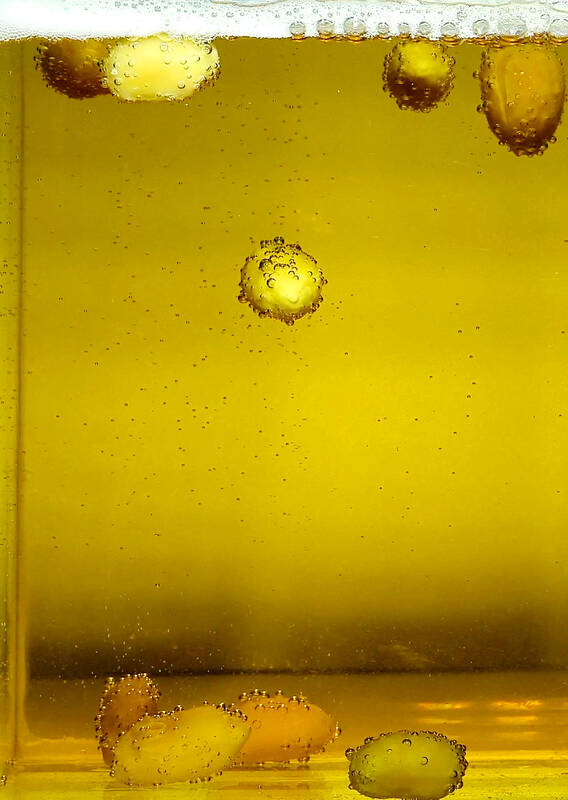When peanuts are dropped into a pint of beer, they initially sink to the bottom before floating up and “dancing” in the glass.
Scientists have dug deep seeking to investigate this phenomenon in a new study published yesterday, saying it has implications for understanding mineral extraction or bubbling magma in the Earth’s crust.
Brazilian researcher Luiz Pereira, the study’s lead author, said that he first had the idea when passing through Argentina’s capital Buenos Aires to learn Spanish. It was a “bartender thing” in the city to take a few peanuts and pop them into beers, Pereira said.

Photo: AFP
Because the peanuts are denser than the beer, they first sink down to the bottom of the glass.
Then each peanut becomes what is called a “nucleation site.” Hundreds of tiny bubbles of carbon dioxide form on their surface, acting as buoys to drag them upwards.
“The bubbles prefer to form on the peanuts rather than on the glass walls,” explained Pereira, a researcher at Germany’s Ludwig Maximilian University of Munich.
When the bubbles reach the surface, they burst.
The peanuts then dive down before being propelled up again by freshly formed bubbles, in a dance that continues until the carbon dioxide runs out — or someone interrupts by drinking the beer.
In a series of experiments, the team of researchers in Germany, Britain and France examined how roasted, shelled peanuts fared in a lager-style beer.
NEXT UP: MORE BEERS
The study, published in the journal Royal Society Open Science, describes two key factors in what the researchers dubbed the “beer-gas-peanut system”.
They found that the larger the “contact angle” between the curve of an individual bubble and the surface of the peanut was, the more likely it was to form and grow. But it cannot grow too much — a radius of under 1.3 millimetres is ideal, the study said.
Pereira said he hoped that “by deeply researching this simple system, which everyone can grasp, we can understand a system” that would be useful for industry or explaining natural phenomena.
For example, he said the floatation process was similar to the one used to separate iron from ore.
Air is injected, in a controlled way, into a mixture in which a mineral — such as iron — “will rise because bubbles attach themselves more easily to it, while other (minerals) sink to the bottom,” he said.
The same process could also explain why volcanologists find that the mineral magnetite rises to higher layers in the crystallised magma of the Earth’s crust than would be expected.
Like peanuts, magnetite is denser, so should sit at the bottom. But due to a high contact angle, the researchers theorise, the mineral rises through the magma with help from gas bubbles.
Of course, science is never settled — particularly when beer is involved.
Hoping to create a better model of the dancing peanut phenomenon, Pereira said the scientists will continue to “play with the characteristics of different peanuts and different beers.”

The canonical shot of an East Asian city is a night skyline studded with towering apartment and office buildings, bright with neon and plastic signage, a landscape of energy and modernity. Another classic image is the same city seen from above, in which identical apartment towers march across the city, spilling out over nearby geography, like stylized soldiers colonizing new territory in a board game. Densely populated dynamic conurbations of money, technological innovation and convenience, it is hard to see the cities of East Asia as what they truly are: necropolises. Why is this? The East Asian development model, with

June 16 to June 22 The following flyer appeared on the streets of Hsinchu on June 12, 1895: “Taipei has already fallen to the Japanese barbarians, who have brought great misery to our land and people. We heard that the Japanese occupiers will tax our gardens, our houses, our bodies, and even our chickens, dogs, cows and pigs. They wear their hair wild, carve their teeth, tattoo their foreheads, wear strange clothes and speak a strange language. How can we be ruled by such people?” Posted by civilian militia leader Wu Tang-hsing (吳湯興), it was a call to arms to retake

This is a deeply unsettling period in Taiwan. Uncertainties are everywhere while everyone waits for a small army of other shoes to drop on nearly every front. During challenging times, interesting political changes can happen, yet all three major political parties are beset with scandals, strife and self-inflicted wounds. As the ruling party, the Democratic Progressive Party (DPP) is held accountable for not only the challenges to the party, but also the nation. Taiwan is geopolitically and economically under threat. Domestically, the administration is under siege by the opposition-controlled legislature and growing discontent with what opponents characterize as arrogant, autocratic

When Lisa, 20, laces into her ultra-high heels for her shift at a strip club in Ukraine’s Kharkiv, she knows that aside from dancing, she will have to comfort traumatized soldiers. Since Russia’s 2022 invasion, exhausted troops are the main clientele of the Flash Dancers club in the center of the northeastern city, just 20 kilometers from Russian forces. For some customers, it provides an “escape” from the war, said Valerya Zavatska — a 25-year-old law graduate who runs the club with her mother, an ex-dancer. But many are not there just for the show. They “want to talk about what hurts,” she